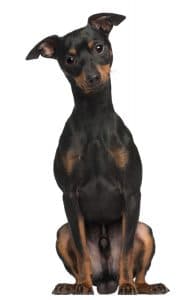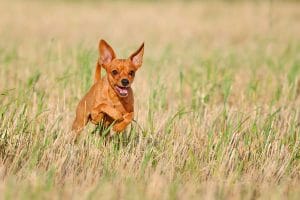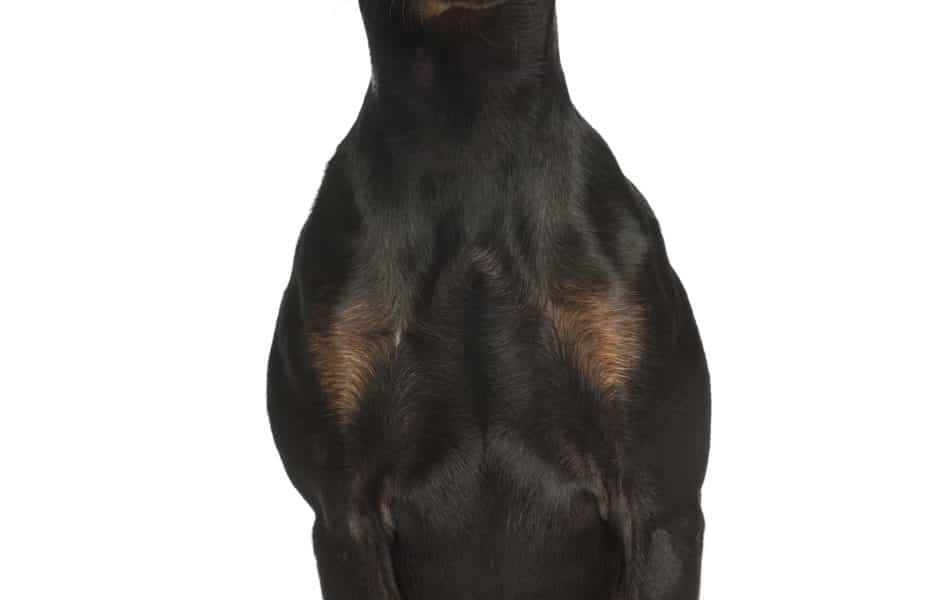
Miniature Pinschers are well-balanced, compact little dogs. They are often mistaken for miniature versions of Dobermans as they’re very similar in appearance but the two are not related. Historical paintings and artifacts suggest that Miniature Pinschers have been around for far longer than Dobermans and it is believed that they are a result of cross breeding smooth-coated Dachshunds and Italian Greyhounds. However, there were no written documents regarding the breed until 1836 when Dr Reichenbach, after years of study, noted his findings as to the breed’s origin. There are theories that other breeds may have been involved in developing the Miniature Pinscher but there is no evidence to support these.
Originally Miniature Pinschers were not bred as house pets but as a working breed for ratting and hunting small mammals. They were often farm animals left to their own devices with very little human contact. This developed a rather independent streak in them, which still forms part of their characteristics today. Unfortunately the breed was not well researched when registered with some Kennel Clubs and were grouped as part of the Toy dog category due to their size rather than being categorised by their working merits. They are often described as the ‘King of the Toys’ because of their bold, lively and spirited personalities. They can be quite ferocious and courageous when necessary.
Physically Miniature Pinschers are small, they only weigh between 4 and 5 kilograms and are around 25 to 30 centimetres high. They have a square body, their skull is slightly narrow and elongated but in perfect proportion to their body. Miniature Pinschers have a strong muzzles and jaws with a perfect scissor bite and ears set high on the head. Their forequarters are quite broad, their chest is deep and topline straight but sloping slightly towards the rear. Legs are straight and feet are somewhat cat like. Tails and ears may be cropped depending on the breed standard adhered to. For example, the AKC standard requires tails to be cropped but cropping is illegal in most European countries.

Miniature Pinschers are a dog breed needing only minimal grooming. A weekly brushing and a bath when necessary will be quite sufficient. The coat lies close to the body and is smooth but stiff. Acceptable colours are black with tan markings, chocolate with tan red markings or stag red (red with black hairs) and solid clear red (ranging from dark rusty red to tan). Blue and Fawn are also acceptable colouring according to some Kennel Clubs but will not be accepted as show standard with the AKC.
These sturdy little dogs are full of personality. They’re lively, alert and full of energy. Miniature Pinschers are particularly proud, brave and courageous dogs. Easily trained and happy to please. However, it should be noted that this breed should certainly not be treated like a lapdog. They are feisty and inquisitive and all of these traits can lead to unwanted behaviour if they are overly pampered.
Miniature Pinschers can adapt to apartment living but they are energetic dogs and do need regular exercise. They will require a daily walk and should be kept in enclosed spaces or on a lead while outside. They are curious dogs who love to explore and will take any opportunity to do so. Miniature Pinschers are suited to being family dogs but they’re not robust enough for rough handling and therefore not be ideal for families with very small children.
Miniature Pinschers are generally a very healthy and hardy breed with few health problems. They can be susceptible to leg injuries due to their small frames, patellar luxation (dislocated kneecap) and Leggs Perthes Disease (hip problems). They should have a life expectancy of around 15 years.


